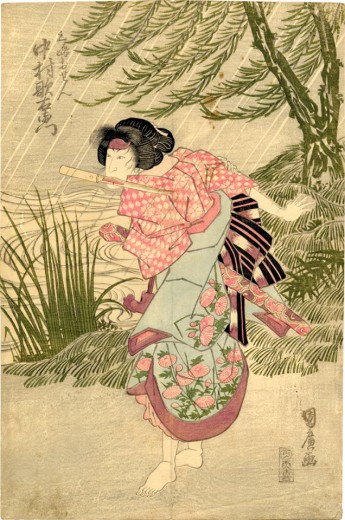Actors playing multiple roles in a play
March 10 (Tue), 2015 – June 7 (Sun), 2015
This museum exhibits Ukiyo-e prints and paintings produced in Osaka mainly in the Edo period. Most of Ukiyo-e paintings made in Osaka were of portraits of actors who played in kabuki theatres in Dotombori area. In those days area around this museum were in a lively atmosphere generated by the actors in portraits.
One of the unique elements of the kabuki play is that all roles including female roles are played exclusively by men. Therefore some male actors were specialists in playing female roles called onna-gata, in the Edo period some of whom lived their daily lives as a woman in order to get right into female role. And then in the second half of the Edo period, playing multiple roles in a play, whether they were male role or female role, became regarded as a proof of an excellent actor.
In this feature exhibition, we focus on actors playing a double role (male and female) in a play. Audiences were able to enjoy various performances by watching an actor trying hard to play multiple very different roles in one play. Please enjoy Ukiyo-e paintings of actors playing a double role.

From “one role in one play” to “multiple roles in one play”
When it originated by Izumo-no-Okuni, kabuki used to be acted only by women. And through the wakashu-kabuki (played by young men) period, it became performed exclusively by men. Initially, roles in kabuki play include tachi-yaku (leading role), kataki-yaku (villain), dohke-gata (clown), waka-onna-gata (young woman), wakashu-gata (young man), kasha-gata (elderly woman), oyaji-gata (elderly man), ko-yaku (child), and it was unusual for an actor to play multiple roles in a play.
But gradually the roles became more subdivided by sex, age, status and profession. Roles like ara-goto (rough style leading role) and wa-goto (soft style leading role) were derived from tachi-yaku, so were kuge-aku (noble villain) and iro-aku (sexy villain) from kataki-yaku, aka-hime (princess) and sewa-nyobo (wife) from waka-onna-gata. As the number of roles increased, a “one role in one play” principle collapsed, and playing multiple roles became regarded as a proof of an excellent actor.
The first actor who acquired a high reputation was Nakamura Utaemon III. He was not so good-looking, but gained popularity by his double role performance. Thus playing multiple roles in a play came to mean the actor’s high acting ability.
In addition to Utaemon, Bando Mitsugoro III, Ichikawa Danjuro VII, Nakamura Utaemon IV and Onoe Tamizo II were among those who gained popularity on the same reason.
Tachi-yaku playing onna-gata
While actors playing multiple roles in a play gained popularity, there were actors who persisted to play one role in a play. Actors who played only female role were called ma-onna-gata. They never played even evil woman or elderly woman roles in order to avoid losing sex appeal.
Kayaku means to play an additional role in a play. There were cases that an onna-gata actor played a male role or that tachi-yaku played onna-gata. When a ma-onna-gata actor refused to play other roles, it is common that tachi-yaku played the additional role as kayaku.
Iwai Hanshiro V, who is introduced here, was an onna-gata actor who was good at playing a young woman’s role by his cute appearance, but also excellently played akuba, evil old woman, or Shirai Gonpachi, a bad fellow. And there were also cases that an onna-gata actor, Arashi Koroku IV for example, played wakashu (young man) because a wakashu role needed to express immaturity and softness, which onna-gata actors were good at.
Audiences must have been pleased to see onna-gata actors play a male role, though in fact it was just male actors playing a male role.